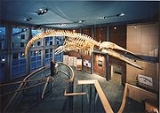
Kobo whale
Encyclopedia

Blue Whale
The blue whale is a marine mammal belonging to the suborder of baleen whales . At in length and or more in weight, it is the largest known animal to have ever existed....
which was accidentally struck and killed by a tanker
Tanker (ship)
A tanker is a ship designed to transport liquids in bulk. Major types of tankship include the oil tanker, the chemical tanker, and the liquefied natural gas carrier.-Background:...
and was brought ashore in Rhode Island
Rhode Island
The state of Rhode Island and Providence Plantations, more commonly referred to as Rhode Island , is a state in the New England region of the United States. It is the smallest U.S. state by area...
in March 1998. KOBO (named for King of the Blue Ocean by New Bedford
New Bedford
-Places:*New Bedford, Illinois*New Bedford, Massachusetts, the most populous New Bedford**New Bedford Whaling National Historical Park*New Bedford, New Jersey *New Bedford, Ohio*New Bedford, Pennsylvania...
student Katie Hallett) is the centerpiece of the New Bedford Whaling Museum
New Bedford Whaling Museum
The New Bedford Whaling Museum is located in New Bedford, Massachusetts, USA. The museum, through its collections and exhibitions, tells the story of the international whaling industry and the history more generally of the "Old Dartmouth" area, the Southcoast of Massachusetts...
’s entrance gallery. Sharing the dramatic space with KOBO is a 33-foot humpback whale
Humpback Whale
The humpback whale is a species of baleen whale. One of the larger rorqual species, adults range in length from and weigh approximately . The humpback has a distinctive body shape, with unusually long pectoral fins and a knobbly head. It is an acrobatic animal, often breaching and slapping the...
skeleton.
History
In March of 1998, a rare blue whale (one of only 500 or so in the north Atlantic) apparently was killed when it surfaced under a ship near Nova ScotiaNova Scotia
Nova Scotia is one of Canada's three Maritime provinces and is the most populous province in Atlantic Canada. The name of the province is Latin for "New Scotland," but "Nova Scotia" is the recognized, English-language name of the province. The provincial capital is Halifax. Nova Scotia is the...
and was struck in the jaw by the propeller. In stormy conditions, the dead whale was then struck by another tanker which unknowingly carried the whale across its bow into Narragansett Bay
Narragansett Bay
Narragansett Bay is a bay and estuary on the north side of Rhode Island Sound. Covering 147 mi2 , the Bay forms New England's largest estuary, which functions as an expansive natural harbor, and includes a small archipelago...
, where it was spotted by a pilot boat and identified. Brought ashore in Rhode Island, it attracted the attention of the international media and the scientific community. The National Marine Fisheries Service
National Marine Fisheries Service
The National Marine Fisheries Service is a United States federal agency. A division of the National Oceanic and Atmospheric Administration and the Department of Commerce, NMFS is responsible for the stewardship and management of the nation's living marine resources and their habitat within the...
placed the skeleton in the care of the New Bedford Whaling Museum to be prepared for eventual display, free to the public, in the planned new lobby gallery.
It is one of only three on display in the world and allows the Museum to make the connection to the need for conservation of endangered whales.
The carcass of the 65 feet (19.8 m), 4-year-old male was initially delivered to the city of New Bedford’s landfill, where a small, dedicated group of trained volunteers carefully removed flesh from the bones. Biologist and renowned skeleton expert Andrew Konnerth was sought out to direct the process of “curing” and then reassembling the bones. He had assembled a number of whale skeletons in his career, but never a blue whale – the largest creature that has ever lived on earth. With the generous help of scores of volunteers and businesses in the community, sections of the carcass were placed in 22 specially built cages and submerged for five months in New Bedford harbor, where marine life continued the cleaning process. The bones were then delivered to the Museum’s courtyard for scrubbing, drying, sun-bleaching, and damage assessment.
At 18 feet long and one-and-a-half tons, the skull and lower jaw required a special shelter outside the museum, which doubles as a workshop. The rest of the skeleton was brought inside the New Bedford Whaling Museum to be restored and reassembled.
A major challenge has been reconstructing the vertebrae that were badly damaged by the impact of the collision. Using blue whale bone samples borrowed from Harvard University
Harvard University
Harvard University is a private Ivy League university located in Cambridge, Massachusetts, United States, established in 1636 by the Massachusetts legislature. Harvard is the oldest institution of higher learning in the United States and the first corporation chartered in the country...
, casts were made out of fiberglass and then painted to replicate the appearance of the original bones. Another challenge was the excessive oiliness of the bones, which caused them to turn deep yellow and smell unpleasant. After various experiments, this unexpected problem was resolved by soaking each bone in a biodegradable solution used to cure leather.

